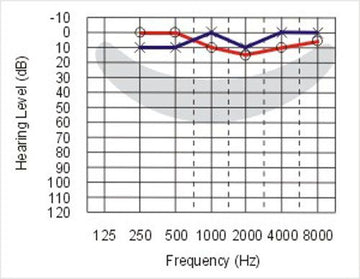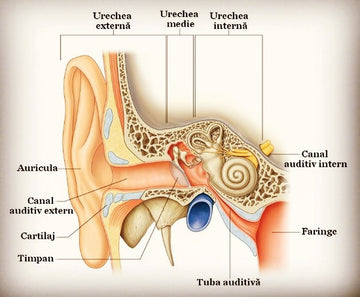
An audiogram is a graph that represents the results of a hearing test, used to evaluate a person's hearing ability. It indicates the type, degree, and pattern of hearing loss by measuring sensitivity to sounds of different frequencies and intensities.
How does the audiogram work?
During the test, the patient responds to sounds with varying intensities for each frequency. The results are represented graphically, as follows:
- The frequency of sounds is indicated on the horizontal axis, measured in Hertz (Hz). Low frequencies (such as 125 Hz) are on the left, and high frequencies (8000 Hz) are on the right.
- The intensity of sounds is plotted on the vertical axis, measured in decibels (dB). The softest sounds are positioned at the top of the graph and the loudest at the bottom.
What does an audiogram indicate?
- Normal hearing loss : Symbols for both ears (O for right and X for left) are positioned at the top of the graph.
- Hearing loss : The symbols are lower in the graph, indicating a higher intensity required for the person to perceive the sound.
- The audiogram can distinguish types of hearing loss: conductive , sensorineural , or mixed .
How to interpret an audiogram?
- Low frequencies (125-500 Hz) : Sounds like a tuba or thunder.
- Mid frequencies (1000-3000 Hz) : Most speech sounds.
- High frequencies (4000-8000 Hz) : Sounds like birds chirping or the consonants "s" and "f".
- If hearing is affected at high frequencies, it may be difficult to understand speech clearly, even if the sounds are audible.
Types of hearing loss
- Conductive : Problems with the outer or middle ear that prevent sound from being transmitted. Common causes include wax, infections, or perforations of the eardrum.
- Sensorineural : Problems with the inner ear or auditory nerve. Can be caused by exposure to loud noises, aging, or genetic diseases.
- Mixed : A combination of conductive and sensorineural loss.
When do you need an audiogram?
Signs that indicate the need for a hearing test:
- Difficulty understanding conversations, especially in noisy environments.
- Persistent noises in the ears (tinnitus).
- The need to turn up the volume on the TV or phone.
- A constant feeling that others are speaking slurredly or "mumbling."
- Difficulty detecting sounds in the environment, such as the doorbell or alarm clock.
Benefits of an audiogram
An audiogram provides accurate information about the degree of hearing loss and helps the audiologist recommend appropriate treatment, including hearing aids or other interventions. Regular evaluation is essential, especially for older people or those constantly exposed to loud noises.
Hearing testing is simple, non-invasive, and an essential first step to maintaining an optimal quality of life. If you have noticed signs of hearing loss, consult an audiologist for an evaluation.
#4
An audiogram is recommended before purchasing a hearing aid , although it is not always absolutely necessary. Here are the reasons why an audiogram is useful:
1. Hearing aid customization
The audiogram provides detailed information about the type, degree, and configuration of hearing loss. Based on this information:
- The hearing aid can be adjusted to amplify the affected frequencies.
- An appropriate model can be chosen, depending on the required technical specifications, such as amplification power or operating frequencies.
2. Identifying complex hearing loss
In cases of:
- Severe or profound hearing loss , requires greater amplification than that offered by standard models.
- Hearing loss in rarer frequencies (below 300 Hz or above 3500 Hz), common hearing aids may not be effective. The audiogram is essential to choose a device with advanced performance.
3. Exclusion of other medical problems
The audiogram is usually performed in conjunction with an ENT checkup, which can detect possible treatable conditions, such as wax buildup, infections, or other conditions that may temporarily affect hearing.
4. Reducing the risk of inappropriate purchase
Without an audiogram, there is a risk of purchasing a hearing aid that:
- It does not correspond to specific hearing loss.
- It is too strong or too weak, which can lead to discomfort or ineffective use.
How is an audiogram done?
- It is a quick (20-30 minutes), comfortable and painless procedure.
- It is performed in an audiology office, using an audiometer.
- The patient responds to sounds of different frequencies and intensities, and the results are recorded in the form of a graph.
Costs and accessibility
- Many audiology centers offer free audiograms, with no obligation to purchase hearing aids.
- The only difficulty may be getting around, especially for elderly patients or those with reduced mobility.
Conclusion
Although not mandatory , an audiogram is strongly recommended before purchasing a hearing aid. It helps to choose the most suitable device, optimizing the hearing experience and ensuring that the device meets individual needs.





